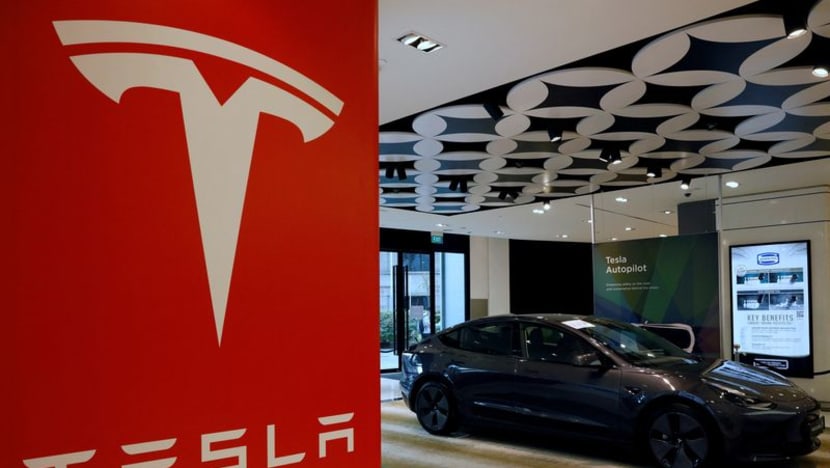ERP 2.0 roll-out delayed for new Tesla cars, LTA finalising installation details
Installation of the ERP 2.0 units for other new vehicles, including electric cars of other makes, is progressing as planned, says the Land Transport Authority.

A Tesla model 3 car is seen in their showroom in Singapore on Oct 22, 2021. (File photo: Reuters/Edgar Su)

This audio is generated by an AI tool.
SINGAPORE: The roll-out of Singapore's satellite-based Electronic Road Pricing system, known as ERP 2.0, in new vehicles has been delayed for Tesla cars.
All new vehicles registered from May 1 are supposed to be pre-fitted with the ERP 2.0 on-board unit (OBU), instead of the in-vehicle unit (IU) for the old ERP system.
“We are still finalising the technical installation details for Tesla vehicles with Tesla Singapore,” said the Land Transport Authority (LTA) on Thursday (May 16). It did not give a reason for the delay.
It added that installation of the ERP 2.0 units for new Tesla cars will be done on "a later date".
Installation for all other new vehicles, including electric vehicles of other makes, is progressing as planned, the authority said.
LTA first began installation of the ERP 2.0 units in August last year with a group of early adopters. It was expanded to company vehicles in November before being rolled out to existing motorcycles and new cars in May this year.
More than 18,000 vehicles have been fitted with the units as of the start of May.
When CNA visited the Tesla showroom in Toa Payoh as a potential customer, staff confirmed that new Tesla cars do not come with the ERP 2.0 units but with the old IUs.
Tesla car buyers whom CNA spoke to said they were hoping for the ERP 2.0 units to be pre-fitted, but they were either not given the option or found out it was not installed when they got their cars.
One driver in his 40s who is scheduled to collect his new Tesla car at the end of the month said he was informed by the salesperson that his car will not have the ERP 2.0 unit.
He said he “does not mind” the new OBU and his only concern is whether the OBU will be compatible with Tesla's electronics.
“The thing is, I don’t know if there are any challenges with installing the new OBU on an electric vehicle due to complications with the electronics,” said the driver.
Another driver who recently bought a new Tesla is 39-year-old Alvin Khoo, who received his car at the end of April.
Although it was ahead of the May 1 date in which new cars would come with a pre-fitted ERP 2.0 unit, he was still surprised that Tesla staff did not ask in advance if he would prefer the new OBU in his car.
Sure enough, his Tesla car came with the old IU.
“I would’ve expected the car to have the new (ERP 2.0 unit) so I won’t have to spend a few hours to get it replaced,” said Mr Khoo, who runs a live band company. “It’s frustrating that it came with the old one.”
But Mr Khoo is looking on the bright side, as having the OBU roll-out delayed means he has a choice of where to place the card reader, such as in the passenger's footwell or the driver's footwell.
This was a choice that was not available to car owners at the start of the installation exercise, but LTA this month made clear that they could choose to place the unit on the driver’s side.
The move came after complaints from some drivers that placing the card reader on the passenger side made it difficult to access.
LTA then rolled out a feature for motorists to disable their payment card at the push of a button on the touchscreen, rather than having to remove their card from the unit.
More recently, the ERP 2.0 system also came under scrutiny from members of the public who questioned whether the OBU meets the global benchmark for electronic devices.
LTA rejected these claims on Tuesday, maintaining that the OBUs meet the relevant international standards.
WHAT MAKES A TESLA CAR DIFFERENT?
So why does a Tesla need more technical assessments before being fitted with an OBU? The reason, said Associate Professor Zhou Yi from the Engineering Cluster at the Singapore Institute of Technology, has to do with the car's electronics system.
"Tesla and many electric vehicles have a battery management system and usually the design is optimised for space, energy efficiency, heat ventilation and safety," he explained.
"ERP 2.0, as a third party permanent installation to the car power system, may need some tests to ensure that it won’t affect the performance of the power system, unless there is a separate power supply for external devices."
He added that it could be more "effective and sustainable" to install the ERP 2.0 application directly into Tesla's system so that appears on the in-vehicle screen.
"For other electric vehicles compatible with Apple CarPlay or Android systems, it should be easy to install the ERP 2.0 app as well," he said.
















